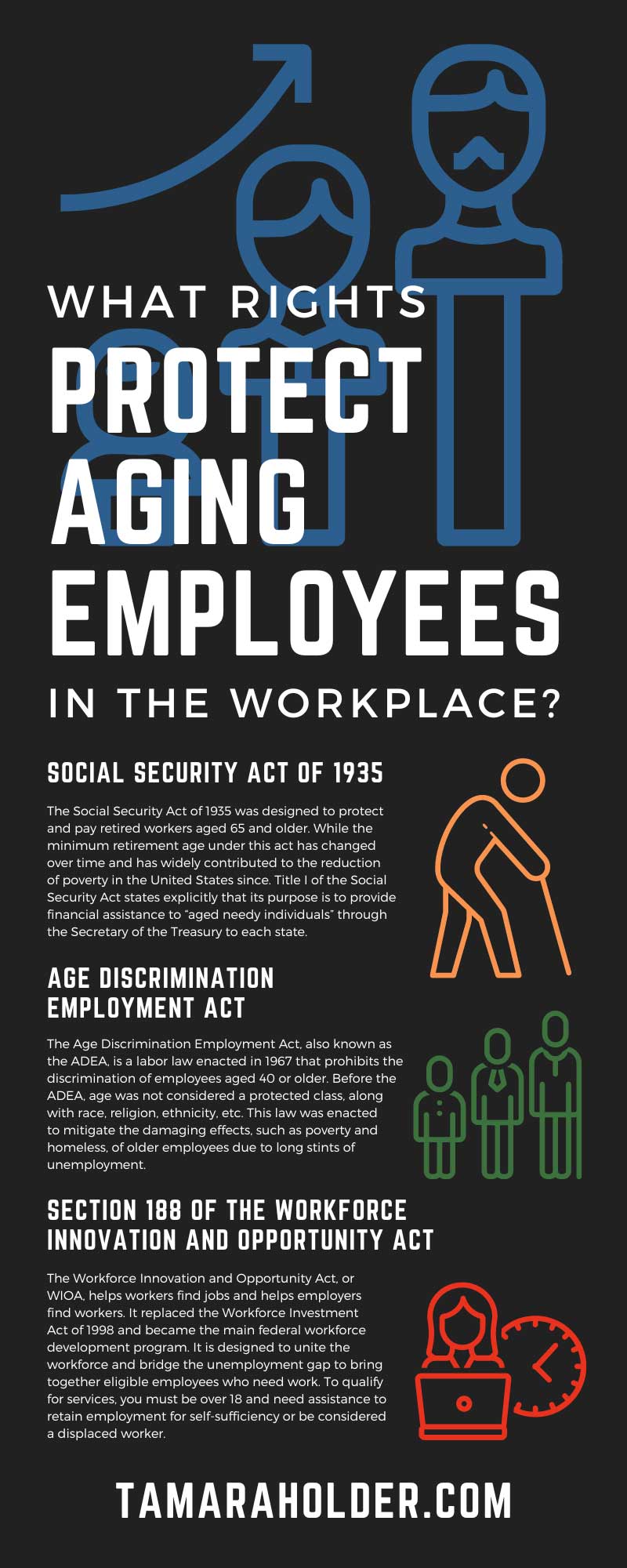Regardless of age, experience, or seniority, aging employees are vulnerable to age discrimination in the workplace. Despite this, older workers are an essential part of the workforce and deserve to have their employers value and respect them, just as any other employee. To help you understand your rights as an older employee, this article will review what rights protect aging employees in the workplace and what you need to know about ageism.
The Age Discrimination Act defines age discrimination as unfavorable or unwanted treatment or harassment of an employee based on age. This form of discrimination can take on many forms, and as employees age, it can directly relate to disability discrimination. This can take on the form of age-related comments or insults, isolation, and even denial of accommodations. Typically, employers use these acts to subtly force older workers out of their job without directly firing them and possibly receiving a discrimination suit.
Despite the illegality of ageism, it is important to note that a rare but existing exemption allows employers to discriminate to a certain degree. This is known as a bone fide occupational qualification, or BFOQ, stating that an employee must have specific attributes and qualities to do a job. Unfortunately, because age can often correlate to physical abilities, employers can deny hiring you or fire you if you cannot complete the activities required in your employment contract. To be precise, if a job requires you to have a certain level of vision, but you develop severe presbyopia, they are entitled to find someone who can do the job.
Furthermore, age is considered a protected class, and though at-will employment states have considerable power, they are not exempt from discrimination laws. The notion that you can get fired for any reason in these states without contest isn’t true.
Likely, you are familiar with this act as many of its facets remain under contention. Still, it is one of the most pivotal acts, partially dedicated to aging workers, that has been passed into law in America. The Social Security Act of 1935 was designed to protect and pay retired workers aged 65 and older. While the minimum retirement age under this act has changed over time and has widely contributed to the reduction of poverty in the United States since. Title I of the Social Security Act states explicitly that its purpose is to provide financial assistance to “aged needy individuals” through the Secretary of the Treasury to each state. This act protects the futures of aging workers throughout America.
The Age Discrimination Employment Act, also known as the ADEA, is a labor law enacted in 1967 that prohibits the discrimination of employees aged 40 or older. Before the ADEA, age was not considered a protected class, along with race, religion, ethnicity, etc. This law was enacted to mitigate the damaging effects, such as poverty and homeless, of older employees due to long stints of unemployment.
The ADEA prohibits denying layoff, training, promotion, benefits, or refusing to hire, fire, or pay an employee on the basis of their age. This includes physical or verbal harassment, including derogatory terms or actions that make an employee feel unsafe. An employer’s job is to provide a safe work environment for their employees, and an active deviation from this is a serious legal issue.
Additionally, it is unlawful under this act for employers to force retirement upon an employee or for employers to enforce a mandatory retirement age. All attempts to force out an employee based on their age is illegal under Federal Law.
The Workforce Innovation and Opportunity Act, or WIOA, helps workers find jobs and helps employers find workers. It replaced the Workforce Investment Act of 1998 and became the main federal workforce development program. It is designed to unite the workforce and bridge the unemployment gap to bring together eligible employees who need work. To qualify for services, you must be over 18 and need assistance to retain employment for self-sufficiency or be considered a displaced worker. However, to mitigate instances of age discrimination in this program, Section 188 was implemented within the WIOA.
Section 188 subsection 1.2 states that individuals cannot be denied benefits based on sex, religion, color, or age. Additionally, this section is further supported by the Age Discrimination Act of 1975, which prohibits age discrimination in programs that receive federal funding.
This program and its supporting legal pillars help ensure that those of any age who are willing and able to work receive employment to better support themselves. While there are still strides to be made in terms of reducing the percentage of unemployed eligible workers, it continues to safeguard Americans across the country, giving them a better chance at a better quality of life.
If you feel you’ve been a victim of age discrimination in the workplace, it is essential to speak out about it. Your first step is to write down what you know, or the situation's who, what, when, where, and whys, so you have consistently clear details about the event. Your next step is to report the incident to your supervisor, manager, or member of HR. If the behavior does not improve, or you do not feel safe discussing these issues with higher management, you may need to take more severe measures. It is entirely within your right to file a complaint within 180 days of the incident with the EEOC and arm yourself with legal representation.
Ultimately, knowing what rights protect you as an aging employee in the workplace is a critical part of staying educated in order to protect yourself. Big-name companies like to take advantage of everyday workers that aren’t intimately familiar with the law, but the Law Firm of Tamara N Holder can help. We can put you in contact with an age-discrimination lawyer with the knowledge and experience to give you the legal representation you deserve.
